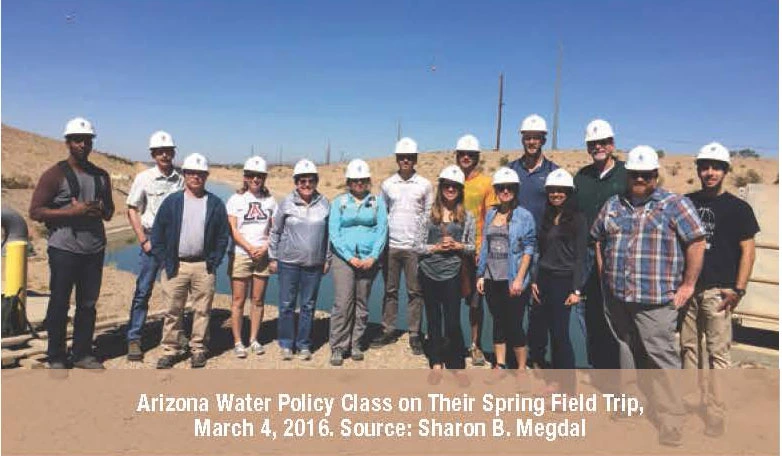Public Policy Review

Spring Semester is always busy and exciting for me, particularly because I teach my graduate course, Arizona Water Policy. Each year the course is a bit different. Because the course attracts students from many different programs, there is always an interesting mix of student backgrounds and interests. Also, while we cover some of the same topics every year, others vary, depending on what out-of-town experts may pay a visit or what water happenings have recently occurred. Regardless of the variations, one thing remains constant – our all day field trip, about which I have written before. This year the field trip took place on March 4.
I truly believe that getting out in the field is an extremely important way to learn about Arizona water policy and management. We can talk all day about recharge and water banking, the Central Arizona Project (CAP), and water reuse, but there is nothing like seeing these things firsthand. Indeed, the day of site visits and briefings is the first thing to be scheduled on the syllabus, and all enrolled students are asked to try to allocate the full day to the class outing.
Our day starts with a stop at Tucson Water’s Advanced Oxidation Process (AOP) Plant and continues on to Tucson Water’s Southern Avra Valley Storage and Recovery Project (SAVSARP). The AOP plant treats polluted groundwater to very high standards for delivery to Tucson Water’s customers. At SAVSARP, vast amounts of CAP water are stored for current and future recovery and use. We then go on to CAP’s Twin Peaks Pumping Plant, where the students learn firsthand about CAP’s reliance on power to pump water uphill from the Colorado River all the way to Tucson. Lunch at the White Stallion Ranch, hosted by BKW Farms, provides a perfect backdrop for reflection and conversation, along with learning about White Sonoran Wheat production in our region. We then go on to Pima County’s new Agua Nueva Water Reclamation Facility, which was built and is operated through a public-private partnership with CH2M. There we learn about state-of-the-art wastewater treatment, as well as effluent recharge. The final stop is Tucson Water’s Sweetwater Wetlands, where wetland treatment and effluent recharge basins operate. The Sweetwater Wetlands, which is open to the public during daylight hours, is truly an oasis in the desert and a favorite birding spot.
The field trip follows the “life cycle” of water use in the Tucson region: groundwater pumping and clean-up, groundwater recharge, water banking, Colorado River water delivery, energy requirements, wastewater treatment and reuse, and some agricultural water use. Although we start out at and return to the urban core, we are in the desert as we ride through Saguaro National Park West and parts of the Avra Valley. We interact with people who make sure we have safe and reliable water supplies and are very grateful for the expertise shared with us by the professionals who meet with us at our various stops. Some are even with us throughout the day! That professionals are so generous with their time shows the value they place on training our next generation of professionals, academicians, and leaders.
My hope is that through spending this busy day in the field, my students gain greater appreciation for the complexities of water management as practiced in our region and also see ways they might contribute to resolving the complex water challenges we face throughout our region, country, and world. The field trip experience provides this important context to my students: a student recently wrote, “…the field trip counts among the most educational days in my time at the U of A”.
During the Spring Semester, I also convene a seminar course for the master’s program in Water, Society, and Policy. This one-unit course is designed to expose the students to a multitude of water topics through seminar attendance and group discussions. We engaged in lively discussions about the various seminars they’ve chosen to attend across campus.
Spring is also when we hold the WRRC Annual Conference, which is covered elsewhere in this newsletter, with more coming in the Summer issue. Preparing for the conference involves a whirlwind of activities on the part of WRRC staff and student workers. This year’s topic, #AZWaterFuture – Tech, Talk, and Tradeoffs, enabled us to cover issues ranging from “wicked problems,” such as Colorado River structural deficits, to innovative solutions, including drip irrigation, technology, and education at all levels and through different approaches. Speakers addressed the difficult tradeoffs associated with living sustainably in the desert and the important dialogues to address these tradeoffs, such as through the Governor’s Water Augmentation Council. While one day can only touch on these important issues, I hope that the conference fostered thought and further dialogue. I sincerely thank all speakers and participants. We at the WRRC will continue to do what we can to bring diverse voices to the conversation and exchange of ideas.

